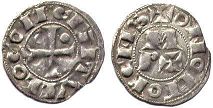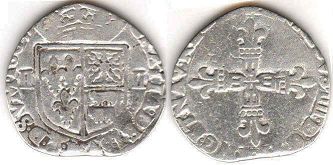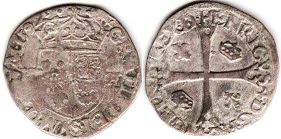Coins of Bearn - catalog with values
Viscounts of Bearn
denier
Centules (XI-XIII century)
 denier no date
denier no date
silver
CENTVLLO COM
ONOR FORCAS / PAX
Coin value ~ 25-35 USD
 obole (1/2 denier) no date
obole (1/2 denier) no date
silver
CENTVLLO COM
ONOR FORCAS / PAX
Coin value ~ 25-30 USD
Ecu=60 sol; Sol=12 deniers; Liard=3 deniers
Henry II (king of France Henry IV since 1589) (1572-1610)
 1/4 ecu 1604
1/4 ecu 1604
silver
GRATIA DEI SVM Q D SVM 1604 / II II
HENRICVS IIII D G FRANC ET NAVA REX
Coin value ~ 90-100 USD
 douzain (1/12 ecu) 1592
douzain (1/12 ecu) 1592
billon
GRATIA DEI SVM Q D SVM 1592 / H / H
HENRICVS 4 D G FRANC ET NAV REX
Coin value ~ 45-55 USD
Louis XIII king of France (1610-1643)
 vacquette (liard) no date
vacquette (liard) no date
billon
GRATIA DEI SVM ID Q SVM
LUDIVI 13 D G F ET NAV REX
Coin value ~ 40-50 USD
Other coins of French Feudalist
Angouleme
Aquitaine
Albi
Anjou
Arches and Charleville
Auxonne
Besancon
Boisbelle and Henrichemont
Bourbonnais
Burgundy
Cambrai
Champagne
Chartres
Chateau-Regnault
Clermont
Comtat Venaissin (Avignon)
Dauphine
Dombes
Franche-Comte
Gien
Kahors
Lorraine
Lyon
Maine
Meaux
Melgueil
Metz
Navarra
Neufchateau
Orange
Penthievre
Poitou
Provence
Sedan
Strasbourg
Toulouse
Tours
Valence
Vienne
Costs of Bearn coins in this catalog approximate and indicated specifically for the coin shown in the picture.
I do not buy or sell coins - this is just a catalog.

